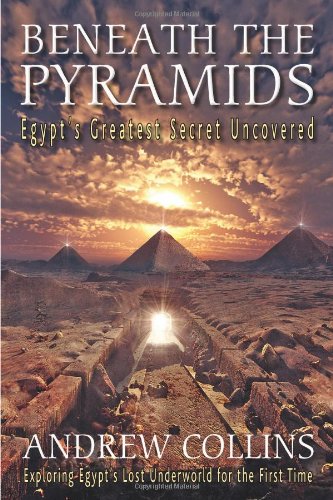For December 2009 Author of the Month, the Forum is pleased to welcome back author and researcher Andrew Collins, presenting an article on the underworld of Giza, both literal and symbolic. Beneath the Pyramids Egypt's Greatest Secret Uncovered is the title of his latest book, evidence from which is featured in this exclusive Graham Hancock Forum article, Giza's Cave Underworld Rediscovered – It is the Entrance to the Tomb of Hermes?
Andrew Collins is a science and history writer, and the author of various books that challenge the way we perceive the past. They include From the Ashes of Angels (1996), which shows that the Watchers of the book of Enoch were shamans responsible for the Neolithic revolution, and that their homeland-the biblical Eden-was southeast Turkey, where archaeologists have recently found the oldest stone temple in the world; Gods of Eden (1998), which reveals that Egyptian civilization is thousands of years older than is conventionally believed; Gateway to Atlantis (2000), which demonstrates that Plato's Atlantis was located in Cuba and the Bahamas, and The Cygnus Mystery (2006), which argues that veneration of the Cygnus constellation was responsible for the world's earliest sky religions. Andrew, born in 1957, lives with his wife Sue near Marlborough, Wiltshire.
For more information go to www.andrewcollins.com
On March 3rd, 2008 I entered a large, yet little understood tomb on the Giza plateau. It was a place I had explored a year earlier, and on that occasion I had found nothing of consequence – no hieroglyphs, no evidence of burials – just strange letterbox-like slots in the walls, where the mummies of embalmed birds might well have been left in honour of some local deity over 2,000 years ago. I had come here again to this neglected area of the plateau, some 806 yards (740 meters) due west of the Great Pyramid, following new information that was set to challenge everything we know about the evolution of Giza's famous pyramid field.
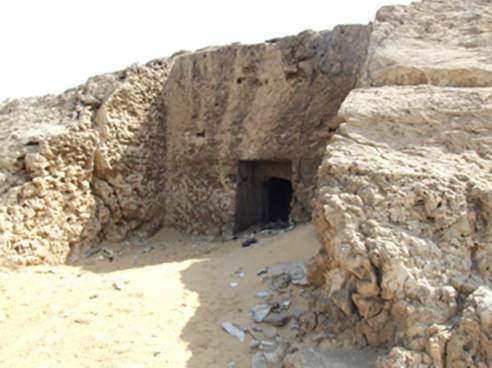
Fig. 1. Giza's Tomb of the Birds, designated NC 2 by George Reisner's team in 1939. They drew a rough plan of the site, but failed to record the presence of the caves.
British Egyptological researcher Nigel Skinner Simpson, a friend and colleague, had been studying the memoirs of Henry Salt (1780-1827), a former British Consul General in Egypt, rediscovered in the basement of the British Museum in 2005, and published two years later by the British Museum Press (Usick and Manley, 2007). Salt was an avid explorer and collector of Egyptian antiquities. What most excited Nigel was the brief but tantalizing mention of Salt and his employee, the redoubtable Italian explorer and former sea-captain Giovanni Battista Caviglia (1770-1845), entering a vast network of "catacombs" that stretched beneath the plateau, a story he had first seen mentioned, if only briefly, in an old biography of Salt (Halls, 1834). However, this had not said where the catacombs were located, only that they lay west of the main pyramid field. This time the information was much more specific, with the site of the catacombs alluded to on Salt's rather distorted plan of the plateau.
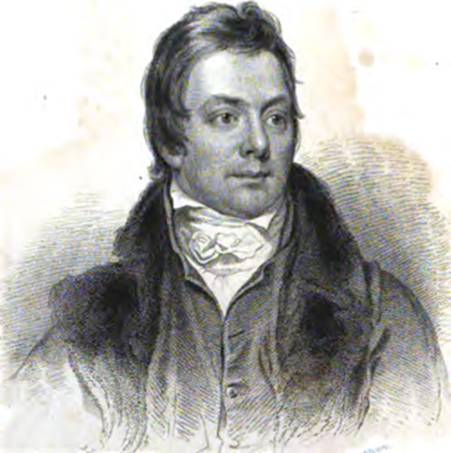
Fig. 2 – Henry Salt (1780-1827)
Inside the caves, Salt and Caviglia had journeyed for an estimated distance of "several hundred yards", crawling on hands and knees where necessary, before eventually coming across a spacious chamber that connected with three others of equal size, from which went various labyrinthine tunnels. Yet because the two men were unable to locate anything of value – no gold or treasure – Salt had given up the search, leaving his Italian colleague to continue on his own. This Caviglia did, taking one of these new cave tunnels for a distance of "300 feet further", before giving up himself.
What concerned Nigel most was the fact that no one in the Egyptological community had ever picked up on the significance of this account dated 1817, which describes an extraordinary cave complex existing beneath the Pyramids themselves.
Explorations at Giza
The next people to have possibly come into contact with these caves after Salt and Caviglia was the British explorer Colonel Howard Vyse (1784-1853) and his colleague, the engineer John Shae Perring (1813-1869). They would appear to have chanced upon the tomb containing the caves during their routine explorations of the plateau in 1837.
Vyse records how during their excavations there, his team carefully removed from its interior a mummified bird of great size(Vyse, 1840). Nothing more is known of what Vyse and Perring found here, although a detailed plan of the plateau prepared by Perring shows the tomb's deeply-cut façade in the rocky north cliff, with dotted lines indicating its interior compartments, next to which is the legend "Excavated tombs and pits of bird mummies" (see also Perring, 1839-40). Whether or not Vyse and Perring explored the cave system is debatable, although Perring's published plan does hint at the fact that they at least went beyond the tomb into the complex's entrance chamber.
After this time no one is known to have visited the rock-cut tomb until American Egyptologist George Reisner came here with his team in 1939, and designated it the identity NC 2, with two other smaller tombs, also found in the north cliff, becoming NC 1 and NC 3. At least two rough plans were drawn of NC2 by Reisner's team, although neither indicate the presence of the caves, a strange oversight in itself. Nothing was written about the tomb, although a comment on one of Reisner's plans offered the thought that it might date to the eighteenth dynasty of Egyptian history, c. 1575-1307 BC. It is a theory that could well have some merit, since the exterior façade is similar to that of at least one key tomb dating to the Amarna period. This said, their interiors are entirely different in style. Whatever the age of the tomb, it seems likely that access to the caves would already have been possible, since they most likely broke through into the plateau's northern cliff face, prior to them being used to create a new tomb.
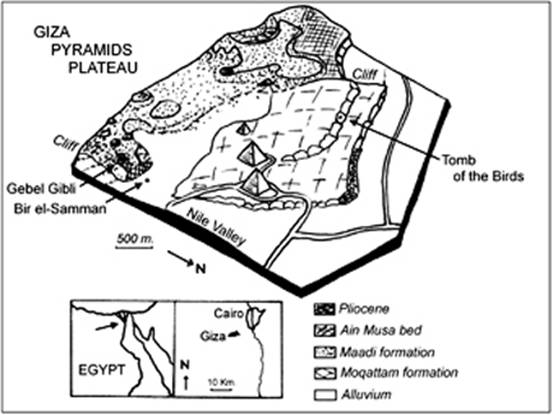
Fig. 3 – Geological map of the Giza plateau, showing the approximate location of the Tomb of the Birds (NC2) and cave entrance.
Rumours and Stories
There is no question that what Salt and Caviglia found in 1817 is of immense importance to the Egyptological world, for rumours of the existence at Giza of a vast underworld of the pharaohs are as old as the Pyramids themselves. Ancient Egyptian creation texts, as well as an assortment of funerary literature, i.e. books of the dead, speak repeatedly of a realm of darkness existing beneath the earth, guarded by demons and snakes. It was through this confusing labyrinthine realm of the night, known as the Duat, that the deceased, in his (or her) role as the sun-god, had to navigate in order to enter an afterlife among the stars. Only by learning and using a series of different spells outlined in these texts, and left on tombs, sarcophagi or in papyrus form, could he hope to handle a sequence of trials and tribulations, involving pits of fire and venom-spitting snakes, before exiting the Duat via its eastern gate on the dawn horizon. From here the pharaoh's ba, or "spirit", usually represented by a hieroglyph showing a human-headed bird, would be free to journey on into the starry firmament.
Underworld of the Soul
Egyptologists have always considered the Duat as a purely mythical concept, meant to strike fear into those hoping to gain any easy passage to heaven. Yet there are clear indications that a physical representation of this nocturnal realm existed somewhere near the Giza Pyramids. This was the conclusion of Egyptian-born Egyptologist Dr Selim Hassan (1893-1961), who for ten years was director of excavations on the plateau on behalf of the Egypt University, Cairo, and later the Service des Antiquités de l'Egypte. He proposed that the Duat's Fourth and Fifth Hours (each of its twelve compartments were represented by one of twelve symbolic hours of the night) seemed different to the rest, and bore the name Rostau which was the ancient name for Giza. Hassan therefore concluded that the descriptions of these particular "hours", as portrayed in a 3,500-year-old text known as the Am-duat, the "Book of that which is in the Underworld", were once part of a quite separate tradition that in some manner related directly to the topography of Giza (Hassan, 1946).
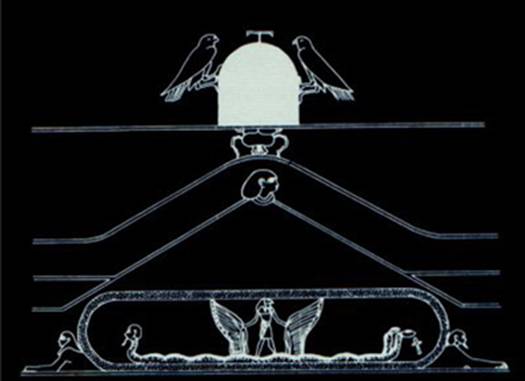
Fig. 4 – The Fifth Hour of the Duat Underworld from the Am-duat text, dating from the New Kingdom period, c. 1575-1087 BC. It is known as the Duat of Memphis, also Rostau, the name given to the Giza necropolis in pharaonic times.
Moreover, the hidden realm of darkness in the Fifth Hour was ruled over by the falcon-headed god Sokar, who in the Am-duat text is shown standing on a massive two-headed snake. Sokar was the patron god of the sprawling cemeteries and pyramid fields that served the ancient city of Memphis, and in particular those at Rostau, ancient Giza. In the area once known as Upper Rostau – Giza South as it is known to Egyptologists today – textual evidence of the former presence there of an important shrine to Sokar have been unearthed (Pasquali, 2007, and Pasquali, 2008). This now lost structure featured in an annual festival involving the falcon-headed god, which celebrated the existence thereabouts of a mythical site called the Shetayet, quite literally the "Tomb of God". Ancient texts tell us that the dweller of this underground sepulchre was none other that the god Osiris, Lord of the Underworld, who lies in a secret chamber somewhere north of Memphis, i.e. in the vicinity of Giza. Other texts preserved on the walls of the temple of Edfu in southern Egypt refer to this same chthonic realm as the Duat n Ba, or "Underworld of the Soul". Here, we are told, mythical beings in an age known as zep tepi, the First Occasion, came in order to celebrate the act of First Creation around the time of a great catastrophe brought about by an "enemy snake" called the Great Leaping One (Reymond, 1969).
Mouth of the Passages
Adding to the belief that a physical representation of the pharaoh's underworld existed at Giza is the name Rostau, which translates as something like "mouth of the passages", an obvious allusion to the entrance to some kind of subterranean realm, perhaps the Shetayet, or Underworld of the Soul. Even after the fall of Egypt with the death of Cleopatra in the first century BC, stories regarding Giza's underworld persisted. For example, the fourth-century Graeco-Roman historian Ammianus Marcellinus (fl. AD 360-390), who travelled extensively in Egypt and wrote concerning the Pyramids, spoke of "subterranean fissures and winding passages called syringes" underneath the plateau, which, he said "those acquainted with the ancient rites, since they had fore-knowledge that a deluge was coming, and feared that the memory of the ceremonies might be destroyed, dug in the earth in many places with great labor" (Ammianus Marcellinus, Roman History, xxii, 15, 30).
After the fall of Egypt to the armies of Mohammed in the seventh century AD, Arab travellers recorded very similar tales following conversations with Coptic Christian priests and monks, who inherited some of ancient Egypt's ancient wisdom. These stories spoke of subterranean passages created beneath the Great Pyramid by a legendary king named Saurid in advance of a cataclysm involving fire from heaven and a subsequent deluge. In these tunnels were placed the arts and sciences of Saurid's age in order that they might be preserved for future generations of humanity. Still further tales voiced by Sabaean pilgrims who came to Giza in medieval times from far off Harran, in what is today southeast Turkey, spoke of the Second Pyramid as marking the site of the cave-tomb of Hermes Trismegistus, with his father, Seth, or Agathodaimon, a kind of demiurge in the form of a serpent, said to repose beneath the Great Pyramid. The site of Hermes' son Sab, from whom the Sabaeans claimed direct descent, was said to have been marked by the "coloured" pyramid, i.e. the Third Pyramid of Menkaure (see Arab sources quoted in Greaves, 1646, for instance).
Critics dismiss such stories as works of fiction, but what seems possible is that they predate the Arab annexation of Egypt, and thus confirm a long held belief in the existence of a subterranean world at Giza. Yet if so, what did this lost underworld contain? Was it natural, or created by human hands, and could its entrance be located today?
Hall of Initiation
It was with questions such as these that the first European explorers arrived at Giza intent on discovering the lost treasures of the Pyramids. As far back as the ninth century the ruling caliph of the Islamic world, al-Mamoun, spent an enormous amount of time and effort tunnelling a hole through into the Great Pyramid, hoping to find gold and treasure. He failed to find the wealth de desired, but those who came after him continued the trend, forever searching for hidden entrances to subterranean tunnels and vaults that were said to connect the Great Pyramid with the nearby Sphinx monument.
It was towards the end of 1816 that the Italian explorer Giovanni Caviglia arrived in Egypt with the intention of clearing away the sand that had engulfed the body of the Sphinx since Roman times. It was an exploration he undertook with the backing of the newly appointed British Consul General, Henry Salt, who would retain the post until his untimely death outside Alexandria in 1827. Why the two men zoomed in on this area of the plateau remains unclear, although it is likely that they were influenced by rumours of pseudo-Egyptian initiations having taken place within hidden compartments accessed via some secret door in the vicinity of the leonine monument.
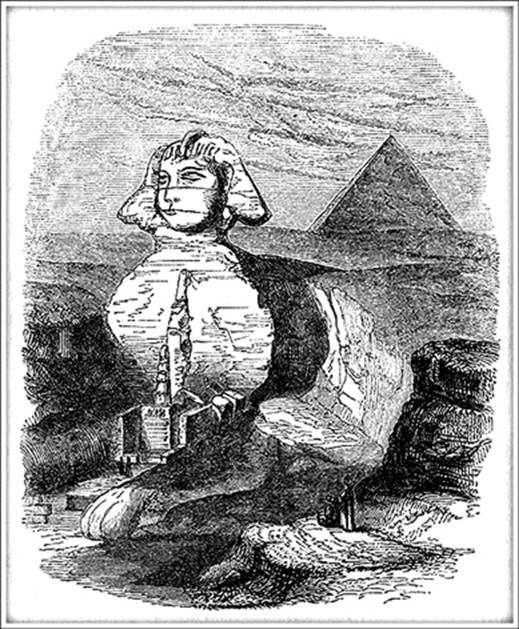
Fig 5 – Line drawing of Caviglia's excavations at the Sphinx after an original by Henry Salt.
One perfect example of this tradition is found in "The Magic Flute" (German "Die Zauberflöte"), the Freemasonry-inspired opera written by Austrian composer Wolfgang Amadeus Mozart (1756-1791), and popular in the years leading up to Salt and Caviglia's arrival in Egypt. Not only does the hero of the opera have to undergo a series of ordeals within the darkness of an Egyptian "temple", but the Sphinx in the form of a dragon has to be defeated, all very reminiscent of the type of trials that the ancient Egyptians expected of the soul as it passed through the Duat underworld on its way to the afterlife.
In the six months that Caviglia spent excavating the Sphinx, no record of him finding hidden chambers has been preserved, although he did find hieroglyphs in some underground chambers accessed via tomb entrances in the sunken enclosure wall behind the Sphinx.
Having established this fact, it had been Salt and Caviglia's discovery of a vast network of "catacombs", or caves, during their explorations of the plateau that had most intrigued Nigel Skinner Simpson and myself. No one in the field of Egyptology had, to our knowledge, mentioned this matter in print. What is more, the commentary accompanying Salt's newly published memoirs misleads the reader by concluding that the "catacombs" in question were located in the wrong part of the plateau (an error admitted to Nigel by one of the authors in October 2009). Despite this obscuration of the facts, Nigel made a thorough examination of Salt's plan of the plateau, and in early 2008 finally traced the true location of the cave entrance. It turned out to be in the vicinity of the mysterious tomb, NC 2, the one that Perring had in 1837 referred to on his plan of the plateau as "Excavated tombs and pits of bird mummies".
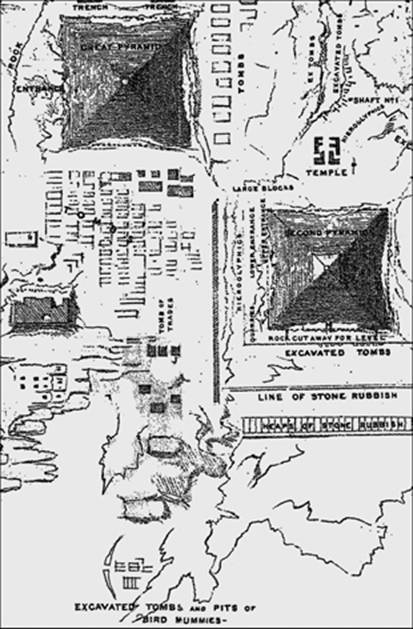
Fig 6 – The section of John Perring's plan of the Giza plateau from 1837 showing the site of the Tomb of the Birds, marked with the legend "Excavated tombs and pits of bird mummies".
Star Correlation
As mentioned at the beginning of this article, Sue Collins and I had visited this strange tomb in January 2007, some months before Salt's memoirs were published, in the belief that it might hold clues concerning the entrance to Giza's lost cave underworld. The reason we had zoomed in on this area was because it figured in a ground-sky correlation featuring the stars of the Cygnus constellation. Although this asterism, known more popularly as the Northern Cross, was seen in classical star lore as a swan in flight, in ancient Egypt its stars appeared to mark the position of the cosmic womb of the sky-goddess Nuit, the mother both of Osiris, the god of death and resurrection, and Re, the sun-god (see Wells, 1992, 1993, 1994. Also Maravelia, 2003). In Egyptian funerary texts, the coffin, tomb and sarcophagus of the pharaoh were themselves representations of the womb of the sky-goddess, within which his soul or spirit might begin the process of transformation and renewal. Such ideas surrounding the soul returning from whence it came, i.e. the womb of the cosmic mother, is echoed within various pre-dynastic burials, where the body of the deceased was laid to rest in a foetal position. Occasionally, the burials are found to contain the bones, bucrania or horns of bovines, a link to the idea that sky-goddesses such as Nuit and her great rival Hathor, the mother of Horus, were seen as dynastic personifications of a primeval Cow Mother, whose divine womb was associated not only with the origins of life, but also the destination of the soul in death.
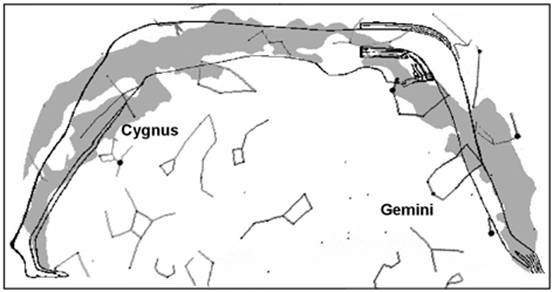
Fig 7 – the sky-goddess Nuit in the form of the Milky Way. The stars of Cygnus marked the position of her womb and navel.
As the sky-goddess Nuit was thought to swallow the dying sun at sunset and then give birth to the new sun at dawn the next morning, the interior of her body, through which the sun-god would pass on its way to regeneration, being identified with the Duat underworld. As such, her womb, in which the spark of rebirth is attained, became the Shetayet, the conceptual Tomb of God – the perceived point of renewal of the pharaoh in his role as Osiris, Re, or, indeed, Horus. This transformation was reflected in celestial terms by the prominent presence upon the Milky Way of the stars of Cygnus, not as they appear in the night sky, but as they exist after setting within the Duat underworld.
Working with British engineer Rodney Hale, I was able to determine that the placement of the three main pyramids at Giza reflected the astronomical positions of three key stars in Cygnus, which in classical star-lore represented the wings of the celestial swan. This star-pyramid relationship is confirmed in the knowledge that from a position southeast of the plateau these same three stars would have been seen to set down into their respective pyramids around the time of their completion, c. 2500 BC.
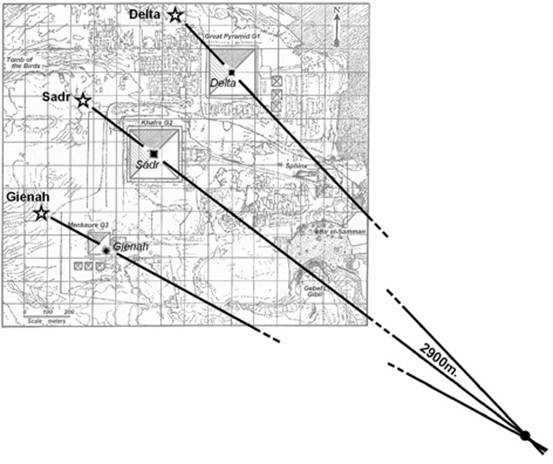
Fig 8a – Cygnus "wing" stars overlaid on Pyramids with corresponding star setting lines, and, Fig 8b, – the Cygnus stars as they would have been seen to set from the southeast in c. 2500 BC.
The Hall of Records
Yet despite this astounding ground-sky relationship, Cygnus's brightest star, Deneb, remained to be matched with a substantial marker on the ground at Giza (it did match with a fairly large mastaba tomb in the western cemetery, but one to which very little is known, other than its designation Lepsius LG 14, given to it by the nineteenth century German Egyptologist Karl Lepsius). The matter puzzled me, and it was not until I presented my findings to a colleague that I was given an unexpected insight into this baffling mystery. Having listened to my discoveries regarding the Cygnus-Pyramids correlation, he looked at the designated Deneb spot on the plateau and said: "What's there?"
Nothing of any significance, I told him.
"Perhaps what you're looking for is underground, and no one has found it yet," he offered, quite matter-of-factly. "Perhaps it's the entrance to the Hall of Records."
It was an interesting and somewhat tangential observation, but one that I was not prepared to accept.
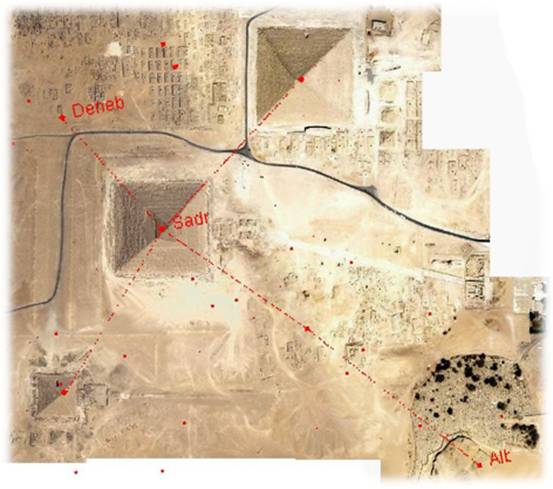
Fig 9 – The Cygnus constellation roughly overlaid over the Giza plateau, showing the approximately position of the star Deneb in the western cemetery.
The Hall of Records was the name given to Giza's lost underworld by the American psychic Edgar Cayce (1877-1945), who as early as 1925 predicted that just such a hidden chamber, containing the records of the ancients, would one day be found in the vicinity of the Sphinx. It is for this reason that the Edgar Cayce Foundation, and its research division, the Association for Research and Enlightenment (A.R.E.), has sponsored a number of high profile scientific expeditions at Giza over the past 40 years in the firm conviction that one day the Hall of Records will be found.
The rediscovery of the lost cave underworld explored in 1817 by Salt and Caviglia might go some way to fulfilling Cayce's predictions in this respect. This seemed especially so, for the entrance to these catacombs seemed to lie not far away from the Deneb spot in the Cygnus-Pyramids correlation. It would appear possible that the dynastic Egyptians saw this bright star as marking the navel of the sky-goddess in her role as the Milky Way – her "legs" being formed by the starry trail's bifurcation to create what is known to astronomers as the Dark Rift, or Cygnus Rift. It is from this perceived celestial "birth tube" that separates the Milky Way between the Cygnus region and the zodiacal constellation of Sagittarius that the much-anticipated new sun of 2012 will be born according to aficionados of the New Age movement.
It was from this same area of sky, marked by the stars of Cygnus, that the ancient Egyptians might well have believed that the soul of the deceased pharaoh would be born anew on the dawn horizon, prior to his ascension as a star among the firmament (Wells, 1992, 1993, 1994). It was probably for this reason that the King's Chamber inside the Great Pyramid was offset slightly from the monument's north-south center line in order that someone lying in its famous granite sarcophagus could have gazed upwards, through the position of the capstone, to the point where the star Deneb would have daily crossed the meridian at its highest point in the sky.
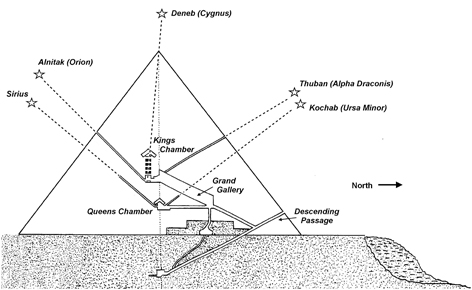
Fig 10 – The Kings Chamber's offset of 6 degrees, 15 seconds, might well reflect an alignment through the pyramid's capstone with the daily culmination of Cygnus's bright star Deneb.
Wonderful Discoveries
Finding that the entrance to Salt and Caviglia's cave complex was in the same general area as the Deneb spot in the Cygnus-Pyramids correlation seemed oddly relevant. So, having determined to locate Salt and Caviglia's lost cave underworld, I now sought the help and support of Edgar Cayce's A.R.E., and made preparations to fly out to Egypt at the beginning of March 2008. Our group's intention was to conduct a second investigation of the tomb, which, I now concluded, might well conceal a hidden entrance to Giza's cave underworld.
Having journeyed to the site on Monday, March 3rd, Nigel, Sue and I entered the tomb and explored its every nook and cranny without discovering the entrance to any lost catacombs. After deciding to abandon our search in favour of exploring other smaller tombs in the same area, we chanced upon a small breach in a stone and mortar wall at the southeast corner of the tomb, something I had missed on our earlier visit. Peering inside, an incredible sight greeted us – a vast chasm-like chamber filled with fallen rock debris. It was a natural cave chamber, over 15 meters square, enhanced in order to make it more rectilinear in appearance. As we gazed inside, flocks of bats, no doubt disturbed by the intrusion of torchlight into their natural habitat, began escaping through the tiny exit.
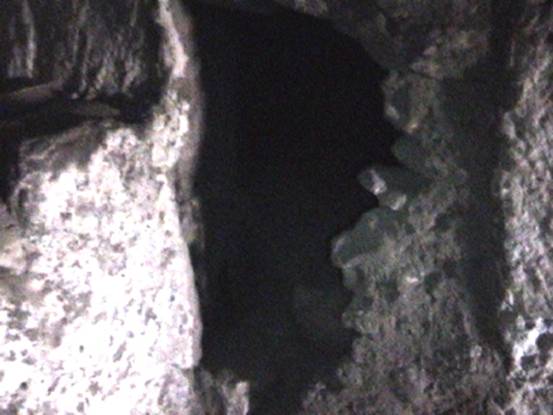
Fig 11 – Breached wall inside the Tomb of the Birds leading into the cave underworld.
Knowing that we could not leave without exploring further, I sank into the depths of the darkness and examined the cave's opening chamber. After exploring some cave compartments in its northwest corner, which were also littered with rock debris, I found and entered a long cave tunnel that headed roughly south. In the pitch black, I navigated a seemingly never ending carpet of huge natural boulders, caused by constant falls from the cave ceiling, which towered to as much as 15 feet (4.5 meters) in height. Strewn across the floor were discarded animal bones, just as Salt had recorded. Here and there, wedged between rocks, were perfectly preserved skulls of large vertebrates that I could not identify.
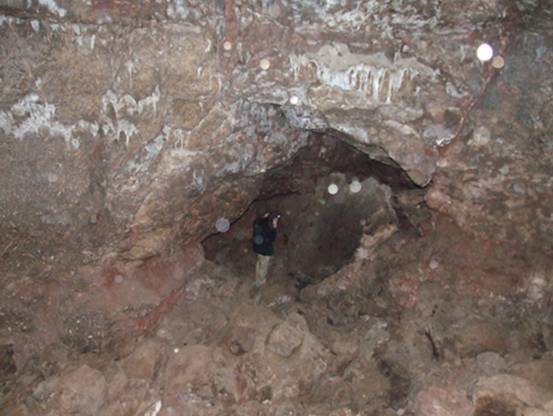
Fig 12 – Inside the opening chamber of Giza's cave underworld, looking towards the northwest.
I penetrated the blackness still deeper, being careful to avoid any unseen pits and holes, our camel guide having joined me. Suddenly, a rush of warm air heralded the imminent approach of more bats that flew just inches away from our scalps. Rising too soon, one hit me squarely in the face, almost knocking me to the ground. Reaching a natural bifurcation in the cave tunnel, we felt it the right time to double back and return to the surface, having taken some 20 minutes to travel just 75 yards (69 metres). Yet I knew from Salt and Caviglia's account that the cave tunnels carried on for a minimum distance of "several hundred yards" before they reached a spacious chamber that connected with three others of equal size, from which went further labyrinthine passages that disappeared into the darkness.
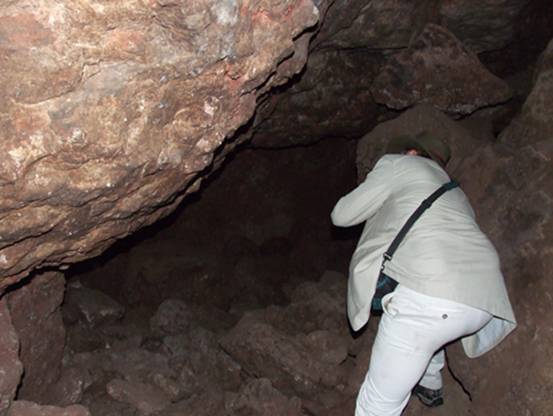
Fig 13 – Andrew Collins in the north-south cave tunnel.
A few days later, Nigel, Sue and I returned to the Tomb of the Birds, as we now referred to it, and Sue and I explored the cave system as Nigel kept watch in the antechamber. The deeper into the rocky darkness we got, the more we became aware that the air was becoming thinner, while the effects of the airborne bat guano were also beginning to take their toll on our bodily systems.
Danger in the Darkness
We were back in Egypt a month later, again with the support of Edgar Cayce's ARE, and twice more, as Nigel waited with walky-talky in the cave entrance area, Sue and I penetrated the caves. The thick airborne guano stifled the air, while the intense heat caused us to sweat buckets, making the experience less than pleasant. Adding still further to our rising concerns over safety in the caves was the tentative identification of a species of venomous spider commonly known as the white widow (a cousin of the black widow). Putting your hand on one of these was not an option, forcing us to cover up our skin completely when in the caves.
Despite all these problems, on our final two occasions in the caves Sue and I reached a conservative distance of around 300 feet (90 meters), maybe a lot more, before we decided to go no further due to very real safety fears. The air became so thin that we began to experience tell-tale signs of hypoxia – oxygen starvation. These peculiar sensations caused us virtually to ignore what was potentially an even greater threat, which was the presence beyond a long stone tube in front of us of an animal or creature heard displacing dirt and gravel. Whether it was a scavenging hyena, hiding out of the way, or something more exotic, we did not bother to find out.
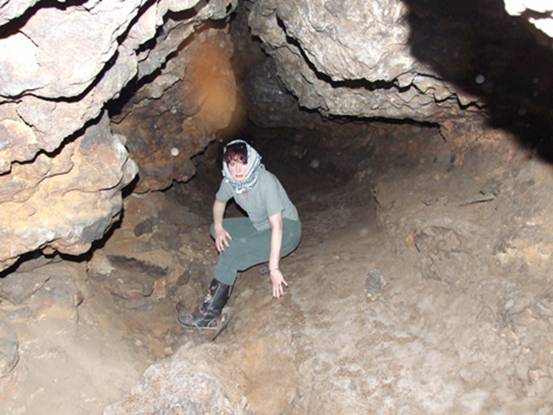
Fig 14 – Sue Collins inside Giza's cave underworld.
Nigel, Sue and I left the tomb knowing that we had rediscovered something quite extraordinary. Clearly, it was not the Hall of Records, the Tomb of Osiris or the Tomb of Hermes. What we do have here, however, is the first, indisputable proof of a natural cave system extending beneath the plateau that was most likely carved out by the actions of water tens of thousands, if not hundreds of thousands, of years ago. It stretches beneath the pyramid field, and very possibly follows the course of local faulting, perhaps reflecting the northwest to southeast orientation of the plateau's underlying geology. Although the caves are entirely natural, here and there in the deepest part of the complex I recorded the presence of incised, parallel lines etched sporadically into the cave walls. Its positioning seemed meaningless, with one set found beneath a curved rock surface. Who carved this, and when, remains a mystery. No hieroglyphic inscriptions, or graffiti of any kind, were noticed, although the limited time in the caves meant that there was much more to search and explore than we could possibly achieve on this visits. The only artefacts noted were mummy remains, including a long cigar-like object that might have contained a small animal. This was observed in the main north-south cave tunnel.
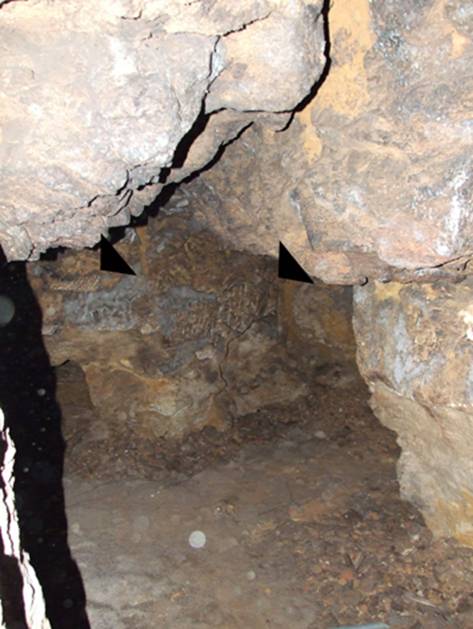
Fig 15 – Two areas of incised parallel chiselling visible in the deepest cave department reached in Giza's cave underworld.
It is possible that the caves might help confirm the connection between the ancient Egyptians' belief in a Duat underworld and Giza's role as Rostau, the "mouth of the passages". Since the caves existed long before the age of the Pharaohs it is likely that they influenced decisions regarding the setting and evolution of the pyramid field. Work done with chartered engineer Rodney Hale highlighted in my book Beneath the Pyramids, demonstrates that the Tomb of the Birds figures in very basic landscape geometry found in connection with the setting of the Giza monuments. As with the geographical placement of the three pyramids, this geometry is locked into astronomical alignments featuring the stars of Cygnus for a date of 2500 BC.
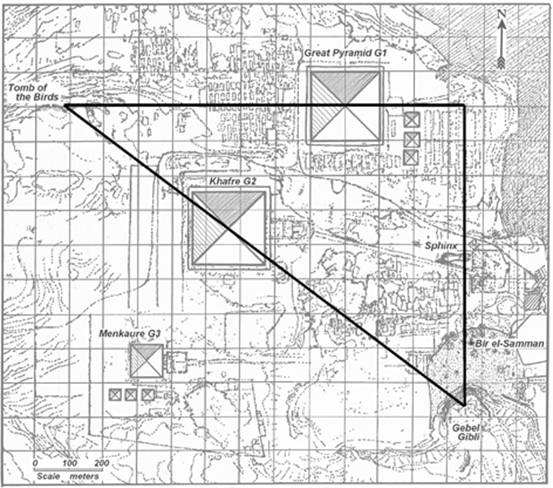
Fig 16 – Based pythagorean geometry at Giza showing the apparent significance of the site of the Tomb of the Birds.
Snake Guardian
Beyond any of this is the story told to us by a local tomb guardian, whom we encountered in the vicinity of the Tomb of the Birds. He was elderly, spoke no English and is unlikely to have been influenced by new age visitors to the plateau. He knew the tomb, but refuses point blank to enter the caves, for they are the abode, he says, of a gigantic snake called el-Hanash. Apparently, it is "nine meters (30 feet)" long, and anyone attempting to enter el-kahf (Arabic for "the cave") will be squeezed to death within its powerful coils. It is a fable, of course, yet one that echoes the very ancient belief that snakes of great size inhabited the Duat underworld, and that a huge serpent called Agathodaimon, the "good spirit", was in Sabaean tradition believed to repose beneath the Great Pyramid.
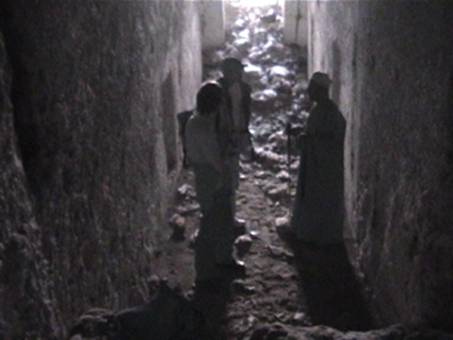
Fig 17 – A Local tomb guardian reveals that the caves are haunted by a giant snakes called el-Hanash.
Afterwards, I heard more about the mysterious el-Hanash. A stone craftsman living in Nazlet el-Samman, the village of the Pyramids, told me that el-Hanash protects the "Hall of Records". Apparently, this great snake of legend spits venom in the face and blinds anyone who tries to enter this underground place and steal a great diamond that it protects. Yet one day, when the end times are near, a chosen one will find the entrance to the Hall of Records, and el-Hanash will blind him only in one eye. It will be this person that goes on to learn the secrets that the ancients knew, and in so doing gain great powers, including the ability to hold back the waters.
It is a strange tale, tainted by modern new age thought, although it seems to echo the ancient Egyptian belief that the Underworld of the Soul, or Tomb of Osiris, contains a power object, like a great egg of creation, that emits an unearthly radiance. Clearly, nothing like this was found in the caves by Salt and Caviglia. Yet they left this underground world only partially explored, as we did ourselves, providing hope that one day this mystery may finally be revealed. Until then, its secrets seem safe under the protection of el-Hanash.
Aftermath – December 2009
This is the story of the rediscovery of Giza's cave underworld as recounted in my new book Beneath the Pyramids. However, so much has happened since news of the discovery became public in August that an update is necessary. Dr Zahi Hawass, the Secretary General of Egypt's Supreme Council of Antiquities, was moved by the enormous amount of internet traffic on this subject (it is featured on over 5,000 web pages and sites to date) to make a public statement denying the existence of the cave system. He suggested that we had simply got confused inside a fully recorded rock-cut tomb of 35 meters in length (see http://www.drhawass.com/node/303).
His dismissal of what he calls "Collins' Cave Discovery" was suitably countered by Nigel Skinner Simpson and myself in statements issued afterwards (see http://www.andrewcollins.com/page/news/hawass.htm). I point out that the hundreds of photos and film footage of the caves ably demonstrate that we entered a natural cave system – the first ever recorded at Giza. This we navigated for a distance of at least 300 feet (90 meters), without reaching the end. Moreover, Salt's memoirs of 1817 make it clear that the caves continue on for many hundreds of yards, and eventually connect up with four "spacious" chambers, from which even further cave tunnels exit into the darkness.
Dr Hawass refuses to budge on his position, creating a stalemate whereby the news media has been extremely reticent about pursuing the subject as a potential news story. This is a shame as we now have new evidence that the caves might follow the course of local faulting beneath the plateau's Mokkatam formation. Radar satellite imagery of the Giza plateau created by the TerraSAR-X satellite, launched in 2007 and operated jointly by Astrium GmbH and the German Aerospace Centre (DLR), shows a shadow line, running from the proximity of the Tomb of the Birds towards the south-southwest, that corresponds pretty well with the positioning beneath the ground of the caves explored so far.
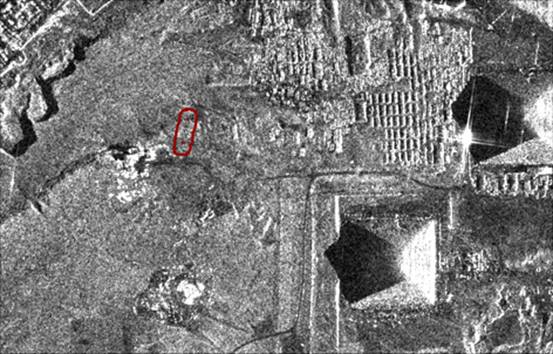
Fig 18 – The section of the TerraSAR-X radar satellite image of the Giza plateau showing a shadow line corresponding to the course of the cave tunnels explored so far (Picture credit: Astrium GmbH and the German Aerospace Centre (DLR)).
There is nothing visible on the ground in the corresponding Google satellite image taken, coincidentally, around the same time in 2007, making this shadow line a mystery, especially as the the TerraSAR-X satellite programme is promoted as being able to detect underground features.
More incredible is the fact that the shadow line on the TerraSAR-X radar satellite image seems to connect with another wider shadow line that starts at a position corresponding to a gully in the plateau's northern cliff, just west of the Tomb of the Birds, and curves towards the Second Pyramid, where it is finally lost from sight on the north side of the monument's square base. Once again, there are no visible features on the corresponding Google satellite map to explain this anomaly (actually, a second, more fainter, shadow line is also seen on the radar satellite image. It commences in the proximity of the caves explored so far and curves towards the Second Pyramid, where it is lost, finally, as it approaches the west side of the pyramid).
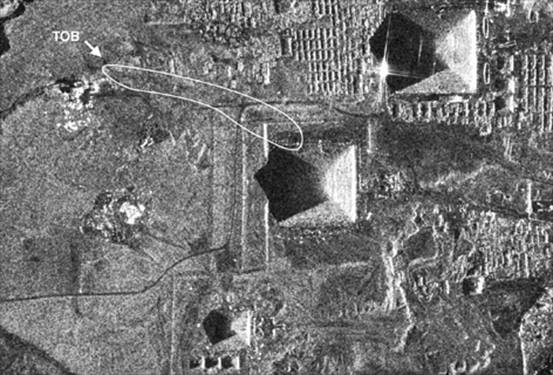
Fig 19 – The curved shadow line on the TerraSAR-X radar satellite map that seems to show the course either of the caves, or localized faulting, which itself might highlight the course of subterranean caves. Not that it disappears on the northwest corner of the Second Pyramid (Astrium GmbH and the German Aerospace Centre (DLR)).
It would be great to consider that this curving shadow anomaly, traced from the area of the caves reached by ourselves to the proximity of the Second Pyramid, shows the course of the caves. This is indeed possible, although the operators of the TerraSAR-X satellite have been unable to comment on the anomaly, saying only that to date they have a relatively limited understanding of just how far their radar technology is able to record sub-surface or subterranean features.
If the shadow lines here described do not mark the course of actual caves, I still suspect that they represent physical features on the plateau. I believe they trace the course of local faulting, which would itself mark the most probable path of subterranean caves carved out by the actions of water across tens if not hundreds of thousands of years.
If correct, then the fact that the shadow lines disappear in the vicinity of the Second Pyramid is very interesting indeed. Not only did the Second Pyramid mark the location of the hidden cave-tomb of Hermes in medieval Sabaean tradition, but in 1977 a scientific survey conducted jointly by the Stanford Research Institute (SRI) and the Ain Shams University, Cairo, used ground penetration radar (GPR) equipment to search for subterranean structures beneath the plateau at Giza. Aside from some interesting discoveries in the area of the Sphinx, the team, under the leadership of geophysicist Lambert T. Dolphin, detected the presence of previously unknown chambers in the vicinity of the Second Pyramid. One, at least, was situated beneath Belzoni's Chamber inside the structure, while another was found beneath the monument's northwest corner on the west side (Dolphin, 1977). Additionally, the team noted the presence of localized faulting on the north side of the Second Pyramid, adding weight to the conclusion that the shadow lines shown on the TerraSAR-X radar satellite imagery really do record the presence of either sub-surface or subterranean geological features.
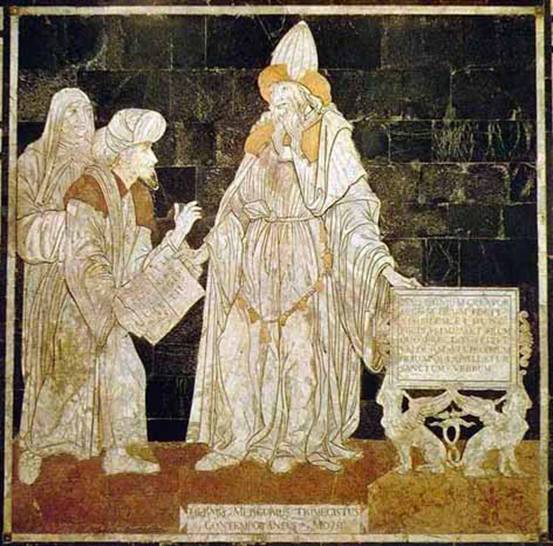
Fig 20 – Hermes Trismegistus as seen in a mosaic in Sienna cathedral.
Since the Tomb of the Birds is approximately 517 yards (473 meters) from the northwest corner of the Second Pyramid, I now suspect that it was into this area that Salt and Caviglia journeyed underground in 1817, this distance constituting the "several hundred yards" they travelled before reaching the reported spacious chambers, from which went other passages. If so, then this is a very interesting realization when we recall the Sabaean belief that the Second Pyramid marked the position of the cave-tomb of Hermes. Is it possible that the bird cult once associated with this site honoured Hermes, the Graeco-Egyptian form of the Egyptian god Thoth, the keeper of ancient records and guardian of the ancient wisdom? If correct then future excavations inside the tomb and caves might well reveal that the bird mummies purportedly left here as ritual offerings (and found by Vyse and Perring in 1837) contained the remains of ibises, a bird sacred to Thoth-Hermes. If the birds found here were not ibises, but raptors, such as hawks and falcons, then the cult here was probably that of Sokar, the guardian of the Duat of Memphis, or Rostau, the ancient name for Giza. Either solution will go some way to prove that the Tomb of the Birds was seen as an entrance into a cave underworld.
According to medieval Arab and European sources the cave-tomb of Hermes (Idris, or Enoch, as he was called in Arabic) housed not only the earthly remains of its owner, but also the so-called Emerald Tablet (also known as the Tabula Smaragdina, the "table of green stone") on which was written the "secret of Hermes", or the secrets of creation. Is it possible that legends relating to the presence in the cave-tomb of the Emerald Tablet is a metaphor for a previously unknown structure at Giza with green stone walls and inscriptions recording the secrets of Egyptian creation? Alternatively, perhaps the Emerald Tablet really did once exist, and was discovered here at some point in the past.
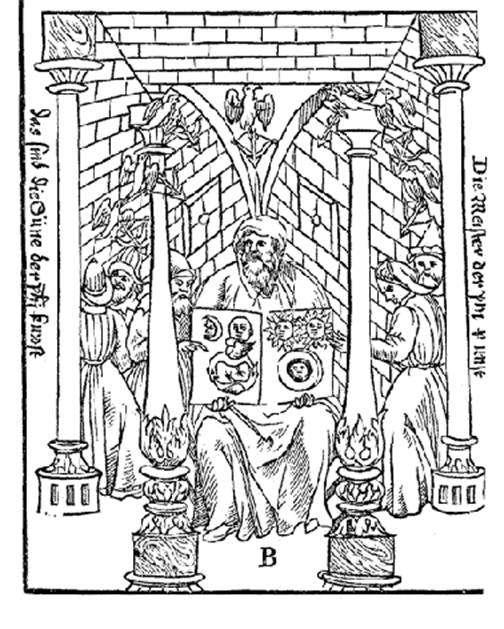
Fig 21 – Medieval illustration of Hermes Trismegistus, showing him holding the Emerald Tablet, containing the key to the secrets of the universe.
If the fact that the Tomb of the Birds was once recognized as the entrance to the cave-tomb of Hermes, then it is possible that long before Salt and Caviglia got into Giza's cave underworld, others were here looking for the legendary Emerald Tablet. Just maybe they found something in the cave's deepest part, perhaps even a green stone fragment that they removed and revered afterwards as a chip from the Emerald Tablet. Whatever the answer, I sincerely believe that we have here a major discovery at Giza – one that is set to reverberate through the Egyptological world for a very long time indeed.
All text and pictures copyright © Andrew Collins, 2009, unless otherwise indicated.
For further information on the rediscovery of Giza's cave underworld, and the latest updates on the subject, visit www.andrewcollins.com
For the full story, complete with additional references, read Beneath the Pyramids by Andrew Collins (4th Dimension Press, Virginia Beach, VA, 2009), available from Amazon and other online book services.
To see revealing footage of Andrew Collins and his team inside both the Tomb of the Birds and Giza's cave underworld during March 2008, watch the following YouTube video.
For more information on Andrew Collins and his work, go to www.andrewcollins.com
Further Reading
Ammianus Marcellinus, Roman History, trans. John C. Rolfe, Loeb edition, 3 vols., Heinemann, London, 1921.
Dolphin, Lambert T., A. H. Moussa et al, Applications of Modern Sensing Techniques to Egyptology, SRI Institute, Menlo Park, CA, September 1977
Greaves, John, Pyramidographia of a Description of the Pyramids of Ægypt, Geo. Badger, London, 1646.
Halls Esq., J. J., The Life And Correspondence of Henry Salt, Richard Bentley, London, 1834.
Hassan, Prof. Selim, Excavations at Giza, Season 1934-35, Vol. VI, Part 1, Annales du Service des antiquités de l'Egypte, Government Press, Cairo, 1946.
Perring, John Shae, The Pyramids of Gizeh, from Actual Survey and Admeasurement. Illustrated by notes and references to the several plans, with sketches taken on the spot, by E. J. Andrews, 3 parts in one vol., James Fraser, London, 1839-42.
Maravelia, Amanda-Alice, "Cosmic Space and Archetypal Time: Depictions of the Sky-Goddess Nut in Three Royal Tombs of the New Kingdom and her Relation to the Milky Way", GM 197 (2003), S. 55-72
Reymond, E. A. E.,The Mythical Origin of the Egyptian Temple, Manchester University Press/ Barnes & Noble, New York, NY, 1969.
Usick, Patricia, and Deborah Manley, The Sphinx Revealed-A Forgotten Record of Pioneering Excavations, British Museum Press, London, 2007.
Vyse, Col. R.W. Howard, Operations Carried on at the Pyramids of Gizeh in 1837, 3 vols., James Fraser, London, 1840.
Wells, R. A., "The Mythology of Nut and the Birth of Ra", SAK 19 (1992), pp. 305-21.
Wells, R. A., "Origin of the Hour and the Gates of the Duat", SAK 20 (1993), pp. 305-26.
Wells, R. A., "Re and the Calendars", 1994, in Spalinger, pp. 1-37.






